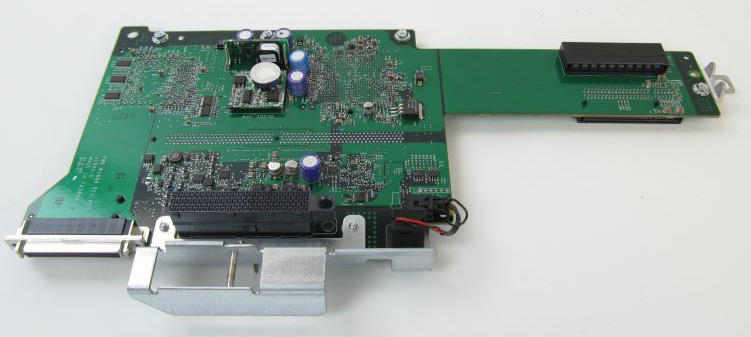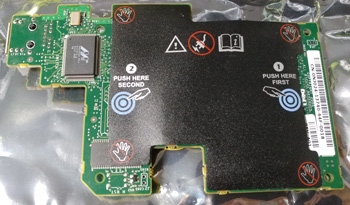My first 'real' server was a Dell PowerEdge 1850 that I got sometime in 2005. At the time it was a powerful machine with dual Intel Xeon CPU's each at 3 GHz, dual power supplies for redundancy, and U320 SCSI hostswap drives on a PERC 4e/Si. Years later I would later upgrade the RAM and storage to it's maximum capacity, but that can only take you so far.
I understand that a server released in 2004 isn't viable when you compare performance per power utilization. Most people would just end up retiring it, but this was my first server. It holds lots of sentimental value.
Standard Upgrades
The storage and memory can be upgraded to it's maximum capacity by spending only a few hundred dollars. This is done with four sticks of HYNIX HYMP151P72CP4-Y5 RAM and two 300 GB 80-pin SCA U320 SCSI drives. A fully loaded Dell PowerEdge 1850 will offer you 4 CPU cores (well, 2 CPUs + 2 threads), 16 GB of RAM, and 300 GB of storage. Those are computing resources comparable to what I would provision for a typical virtual machine workload.
The maximum capacity of a U320 SCSI drive is 300 GB. That's nothing by today's standards and it's getting more difficult to find new drives for spares/replacements. The chassis has no mounting locations for additional drives and no connectors to power them. The backplane used by the U320 SCSI drives can not be replaced.
It all sound dire and depressing but even with these limitations the storage on a PowerEdge 1850 can be upgraded to (fairly) modern standards. This is a multi-part series on what storage upgrades are possible beyond the normally available options for getting a little more out of your Dell PowerEdge 1850.
Mandatory Prerequisite
It's more than likely that your PowerEdge 1850 has a PCI-X riser card. Dell has an upgrade option where you can swap it out for a more modern PCI Express version. At the time the PE 1850 was released, PCI Express 1.0 had made it's way onto the market. Having a PCIe slot expands your upgrade options significantly. The part number you want is 0N8439, so named a "Dell 1850 Riser Card / Raid PCI-E". It's not impossible to find it, but they are also not very common. eBay had some for approximately $50 with free shipping.

It will be nearly impossible to do anything without first upgrading the PCI riser. The rest of this guide will be based on your Dell PowerEdge 1850 have the PCI Express bus.
Optional Extra
If you can (and you should be able to), get the Dell Remote Access Card 4 (DRAC 4) if you don't already have one. The part number is NJ024. It's a really inexpensive add-on that can be found on eBay for under $20 with free shipping if you look hard enough.

The DRAC 4 is not as fancy as the modern stuff like IMM, iLO, or iDRAC6. You won't get a remote console[1] but you can shutdown, restart, and power off the server remotely. It also lets you mount virtual media and recive remote alerts and moitor server health.
The Problem
The PowerEdge 1850 chassis can't accommodate additional 3.5 or 2.5 inch drives and whatever we add has to be powered by the PCIe bus alone. There are a few ways we can approach this problem. Here are some viable options that (in my opinion) won't end up being too "hacky":
- SAS HBA controller with an external enclosure (occupies a single PCIe slot).
- M.2 (aka NGFF) or 2.5" SSD's that get mounted a PCIe card with built-in ACHI/RAID (occupies a single PCIe slot).
- M.2 (aka NGFF) or 2.5" SSD's that get mounted a PCIe card with a separate HBA/RAID (occupies two PCIe slots).
- M.2 NVMe to PCIe (occupies one or two PCIe slots depending on needs).
The first option is the most flexible but can get expensive and may be overkill for most people. If your Dell is limited to PCI-X then option 1 (and maybe even 3) are your only way forward. I want to keep everything self-contained, with no external components, and have the OS handle any RAID features. Option 2 is the most elegant and fits that 'self-contained' preference. It looks great on paper, but in practice I found it to be very troublesome. Mainly because of the poor selection in storage adapters that include on-board M.2 slots. The 3rd option is similar and while not as elegant, does offer a better choice of adapters. This just leaves the 4th and last option... NVMe? really??
Your old PowerEdge from 2004 can indeed use NVMe SSDs with some caveats. You can't boot from it and most importantly your operating system must have support for NVMe. The other caveat is you won't get the advertised 2400+ MB/s speeds. The Dell PowerEdge 1850 having only a first generation PCI Express bus (Gen 1/1.0) will limit that to ~1 GB/s. That's still a lot better than the built-in U320 interface.
Lets go Shopping
A quick note before we continue. As you may have noticed, I am providing links to recommended products using my Walmart associates account. Using my links to purchase your items is a great way of saying thank you and supporting the work I do.
You'll need an Adapter
To make this work we need to buy a M.2 NVMe to PCIe 4x adapter. These are plentiful and inexpensive. Here are a few options to choose from Amazon.
For the purpose of this guide you will need two M.2 NVME to PCIe x4 Adapters. This will occupy both of the PCI slots in your server. It is possible to use only one, but you won't have any options for redundancy.
Boot Drive
It's not possible to boot from NVMe with the PowerEdge 1850. Until someone makes a reasonably priced 80-pin SCA to SAS/SATA converter we need SCSI disks for the OS boot volume. Sadly it's getting near impossible to find new U320 SCSI HDDs. The good news is that these type of disks are incredibly robust. A used set enterprise class disks are more than fine. This is why we have a RAID mirror and our important data will be stored on the NVMe SSDs. You can find used disks at eBay, but it's really hit or miss with them. Walmart has a listing in limited quantities.
Find a capacity that you feel comfortable with. 36 GB is the low end while 147 GB is on the high end. 73 GB might be a reasonable middle ground. I doubt you'll need a 300 GB OS volume. It would be wise to keep a few spares since availability is probably not guaranteed.
There is a slightly less optimal alternative to using SCSI (depending on your use case). The Dell PowerEdge 1850 can boot off USB and PXE. A USB flash drive containing the boot volume may be all you need.
NVMe SSDs
Any M.2 NVMe SSD should work. Make sure it's NVME and not SATA. Here are a few options I've procured from Amazon. I personally have a bias towards Western Digital, but you do what you like best.
The 500GB WD Blue SN550 NVMe drive from Walmart offers a reasonable price vs capacity. These will be setup in a mirrored configuration so you'll need two.
To be continued...
Get those items ordered and delivered. Most of them can be had with free next day shipping if you are an Amazon Prime member. Click the link to sign-up for a free 30 day trial. In part 2 of the series we will install the new components into our server.
[1] Check our home page for an article on how to build an IPKVM using a Raspberry Pi and piKVM to get a remote console.


.png)